
USA & CANADA (848)
Latest News
Canada’s National Housing Strategy: Is it really addressing homelessness and affordability?
Tuesday, 29 November 2022 02:20 Written by theconversation 
Jacquie Gahagan, Mount Saint Vincent University and Ren Thomas, Dalhousie University
The National Housing Strategy (NHS) is a 10-year, $72-billion effort launched in 2017 to address key areas in the Canadian housing landscape. Its goals include increasing housing affordability and reducing homelessness. But research shows that halfway through implementing the strategy, the vast majority of people in core housing need — below the thresholds for housing adequacy, affordability or suitability — are not benefiting from NHS programs.
Housing need is measured differently across countries: for example, the OECD indicators for housing affordability include:
- Housing-related expenditure, including rent, maintenance and repair, and utility bills such as water and electricity.
- The ratio of housing costs over income.
- Ability of households to keep the dwelling warm.
- Subjective measures on housing. These include the percentage who are satisfied with the availability of good, affordable housing in their city or area; who have not had enough money to provide adequate shelter sometime in the last 12 months; who are satisfied with the current public transit systems; who feel safe walking home at night; and who are satisfied with their city or area.
Using these measures and datasets from around the globe, the OECD concludes that housing expenditure increased on average by five percentage points from 2010 to 2015, although housing expenditure decreased in a number of OECD countries, such as Mexico, Bulgaria and Lithuania.
Housing cost burden as a share of disposable income is highest among low-income households, regardless of the country. The OECD considers people overburdened by housing costs if they spend over 40 per cent of their disposable income on housing. Housing insecurity has increased in most OECD countries in the past 15 years, though eight out of 10 Gallup poll participants (of which there were about 1,000 from each OECD country) were satisfied with their city/area.
Core housing need
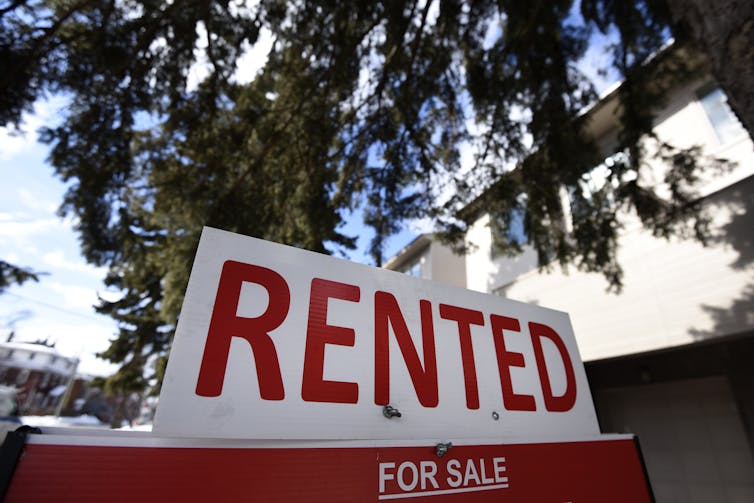
In Canada, just over 10 per cent of households are in core housing need. That means they either live in housing that is unaffordable (defined as costing more than 30 per cent of their pre-tax household income), unsuitable (the size of their household is too large for their unit) or inadequate (their housing is in poor repair), and they cannot afford alternative housing in their community.
Households in core housing need range from a low of 6 per cent in Québec to a high of 32.9 per cent in Nunavut, using 2021 Census data. Renters are also much more likely to be in core housing need: 20 per cent of renters compared to just 5.3 per cent of owners.
Affordability is the major housing challenge, affecting 77 per cent of people in core housing need. The OECD measure for housing cost burden excludes income tax and uses a higher threshold (40 per cent of household income) compared to the Canadian measure of core housing need, which includes income tax and uses a threshold of 30 per cent.
The NHS, launched in 2017, was meant to decrease the number of households in core housing need, but the level remained stable at 12.7 per cent of all households from the 2006 to the 2016 Census, and most provinces and territories haven’t seen much change. Those that have (such as Québec, P.E.I. and New Brunswick) started seeing decreases from 2006 onwards, well before the NHS came into effect.
Slow movement on affordability
The NHS has had little effect on affordability, with most of its programs focusing on market housing and private sector developers. The federal Office of the Parliamentary Budget Officer reviewed the NHS in 2021, and found that there has been just $37.5 billion spent or planned to be spent over ten years, including $12 billion that was committed before 2018-19. The remainder is loans that need to be paid back, and cost-matching funds on joint provincial/territorial programs that were counted twice.

As economist Marc Lee pointed out in a policy note for the Canadian Centre for Policy Alternatives, there has been very little increase in federal spending on housing since 2008: about 0.1 to 0.2 per cent of GDP. In his breakdown of the programs being used to fund new housing construction or renovation of existing units, Lee notes that 55,458 units were announced as funded through NHS programs. However, just 17,497 of them are affordable, with each program using different criteria for affordability, including requirements to stay affordable for a certain number of years.
The National Housing Council published a damning report in February 2022 showing that just three per cent of units produced through the Rental Construction Financing Initiative would lift households out of core housing need. The NHS program provides developers with low-cost loans to build rental housing.
Only one NHS program, the Rapid Housing Initiative, produces units that do not cost more than 30 per cent of pre-tax household income and that stay affordable for 20 years.
The National Housing Council noted that supply created through the NHS does not meet the needs of those in core housing need, and will likely not change the number of people in core housing need. It recommends moving funds away from market-driven programs like the Rental Construction Financing Initiative and towards bilateral programs and demand-side interventions like the Canada Housing Benefit: a program for low-income households who are spending over 30 per cent of their household income on market rent in their area.
For example, in Ontario, the Canada-Ontario Housing Benefit helps people who are on the waiting list for public housing.
Potential improvements
Innovations seen during the pandemic, such as increased uptake of the Rapid Housing Initiative to convert hotels to shelters for people experiencing homelessness, could be extended. The 2022 Federal Budget recommended an increase to funding for the Rapid Housing Initiative program that includes renovations of existing buildings and modular construction.
In 2020, housing policy researcher Steve Pomeroy recommended regulating the purchase of naturally-occurring affordable housing by real estate investment trusts (REITS) and capital funds as a policy to strengthen the NHS. Purchases by these investors resulted in the loss of 320,000 affordable units from 2011 to 2016. Enabling non-profits to buy these units instead, for example through the right of first refusal when they come up for sale, would ensure these units stay affordable long-term.
The creation of more permanently affordable housing, such as modular units, and strategies to increase people’s ability to pay for housing, were also among Pomeroy’s suggestions.
The National Housing Strategy Act asserts that housing is a human right and that the NHS would focus on improving outcomes for people in the greatest housing need, as well as including engagement of diverse groups and achieving social, economic, health and environmental outcomes.
However, major decreases in core housing need won’t come through the current NHS programs. Recommendations from several key reports published in the past two years would strengthen the programs to deliver substantially more affordable units through construction, acquisition and renovation to make sure that our most vulnerable households are safely and permanently housed in the future.
Housing, as a key determinant of health, deserves our full attention now.
Holly Blackmore co-authored this article. She is a graduate from the Dalhousie University Planning program where she completed her undergraduate degree under Prof. Ren Thomas’s supervision.
This is a corrected version of a story originally published on Nov. 16, 2022. The earlier story said National Research Council instead of National Housing Council.![]()
Jacquie Gahagan, Full Professor and Associate Vice-President, Research, Mount Saint Vincent University and Ren Thomas, Associate Professor, School of Planning, Dalhousie University
This article is republished from The Conversation under a Creative Commons license. Read the original article.
The criminal justice system is retraumatizing victims of violent crime
Tuesday, 29 November 2022 02:19 Written by theconversation 
Jeffrey Bradley, Carleton University
In a split moment, violence can change our lives. We could become a target of violence in our home, school, workplace and community. You might be slapped, punched, stabbed or shot, resulting in serious injuries, trauma or even death.
When someone is victimized, adequate support services should be available to help victims and ensure their rights but, unfortunately, they rarely are in the Canadian criminal justice system.

After several months of public criticism, the federal government recently appointed a new Federal Ombudsman for Victims of Crime in September. The new ombudsman will continue the work of making recommendations about systemic and emerging issues in the federal system based on concerns raised by victims.
The House of Commons standing committee on justice and human rights is currently studying the government’s obligations to victims. The study is generating an important debate on existing policies, programs and legislation that could better align the justice system with the needs of victims.
Victims retraumatized
In the aftermath of violence, victims typically feel pain, shock, fear, grief and anger as a result of its physical, psychological, spiritual and financial impacts.
The 2019 criminal victimization survey from Statistics Canada found that 2.6 million people over the age of 15 were victims of a violent incident including sexual assault, physical assault and robbery.
In addition, there is a disproportionate impact of violent victimization on Black and Indigenous people, young women, sexual minorities and people with disabilities. With many intersecting identities, marginalized people face a higher risk of violence because of racism, sexism, homophobia and ableism.
However, only about a quarter of victims of violence reported the incidents to police because most had little confidence they’d be taken seriously and feared being re-traumatized by the legal process.
The criminal justice system is ineffective at addressing the harm done to victims because it centres around punishing the accused perpetrators of violence. The system does not adequately support the victim’s healing. Instead, it uses them to punish people the Crown believes can be found guilty.
In 2018, the Department of Justice completed a review of Canada’s criminal justice system and found that victims are disillusioned and feel re-victimized by the current approach. These findings align with many declarations from victims of sexual violence about their experiences with the legal system where they are blamed and shamed for the harm done, have little agency in the court proceedings and receive limited access to counselling and compensation.

Retributive justice not the answer
Increased policing and prisons are not a solution to these issues because they can lead to further violence and exclusion for the most vulnerable people in society. If an accused person is found guilty of a violent offence, they will likely be sentenced to prison where they often become angrier, more violent and excluded, putting more people in harm’s way.
Complex social and economic inequalities also play a role in violence. But conditions of racism and poverty continue to be ignored by the state.
Instead, the default responses continue to be hyper policing and mass incarceration of disadvantaged people. Black people are 20 times more likely to be killed by the police than a white person in Toronto. Indigenous Peoples make up around five per cent of Canada’s population, yet account for 32 per cent of the federal prison population.
Instead of addressing the root causes of violence, retributive justice perpetuates a vicious cycle where people are punished, stigmatized with a criminal record and released back into communities with limited support. The system dehumanizes and sets up criminalized people to fail, without adequate housing, employment and social support.
Restorative justice
Victims’ needs typically start with not wanting the harm to happen to anyone else. Victims want answers to their questions. They want to know why the harm happened and what will be done to repair the damage so the person who caused the violence can take responsibility and make changes in their lives. Reparations, either symbolically with an apology or financially, can go a long way to help victims recover.
Restorative justice (RJ) is an alternative approach that uses dialogue to address violence where victims, people who caused harm and community members come to an agreement on what should be done to reconcile and transform the root causes of the problem for individual, cultural and societal change.
RJ allows victims to have their voice heard and to hold people who cause harm accountable by making amends and changing behaviours. The community also sets up a broader support system to prevent future victimization using education and social networks.
But restorative justice programs need co-operation and funding from the criminal justice system and the government to scale up initiatives across the country.

In 2015, the federal government adopted the Victims Bill of Rights Act, which gave victims of crime the right to information, protection, participation and restitution.
However, a 2020 progress report from the ombudsman found that implementation of the bill has been sporadic and inconsistent because it has no strategic action plan, limited training opportunities for justice officials, poor data collection measures, little public awareness or outreach about victims; rights and a lack of funding for restorative justice.
The bill also left out the most important right: support services for victims at a standard level throughout the country. Victims’ rights are not enforceable by law and the legislation only provides a complaints process to remedy the situation.
The justice and human rights committee is scheduled to release a report next year. Hopefully, the federal government will make the necessary reforms to increase funding for provincial and territorial governments that will allow them to administer victim services and restorative justice.
The federal government also needs one office for victims that works across departments and jurisdictions to implement a renewed victims’ strategy, one that goes beyond small pilot projects and public education about victims’ role in the criminal justice system. The office should engage regularly with non-governmental organizations and grassroots collectives so the voices of victims are heard and changes are made.
Providing victims with dignity, respect and fairness requires more than words. It must include real actions to support their needs, providing more options for restorative justice and changing the way systems run to be more human-centred and to uphold rights.![]()
Jeffrey Bradley, Ph.D. Candidate, Legal Studies, Carleton University
This article is republished from The Conversation under a Creative Commons license. Read the original article.
How the Canada Border Services Agency tolerates and even encourages refugee mistreatment
Tuesday, 29 November 2022 02:01 Written by theconversation 
Kathryn Tomko Dennler, York University, Canada and Brianna Garneau, York University, Canada
Refugee advocates have long known about systemic problems with immigration enforcement in Canada, resulting in wrongful detentions and deportations, as well as people being tortured upon return to their countries of origin.
Our new research explains why these problems exist.
Flaws in Canada Border Services Agency’s (CBSA) structure and mandate mean that misconduct is tolerated and even incentivized. Independent oversight of CBSA and legislative changes are needed to protect refugee rights.
Deportation affects refugee rights
Our findings show that more than half the people deported from Canada each year made refugee claims. While some people are ready to return home, others still fear persecution.
Decisions on a refugee claim can be wrong. Outcomes of refugee claims depend on the Immigration and Refugee Board member who hears the claim, the quality of legal representation and subjective credibility determinations made by those hearing claims.
People who are at risk of persecution, torture or worse can be denied refugee status and face imminent deportation. For these reasons, deportation is closely linked to refugee rights.
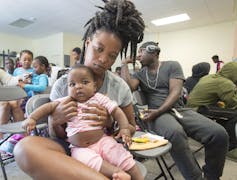
How someone is treated during the deportation process matters. CBSA places an emphasis on “timely removals” at the expense of respecting rights. And although Canada prides itself on its safeguards, they are insufficient.
For example, people can apply for a pre-removal risk assessment to demonstrate the risk they face prior to being deported. The risk assessment was created to meet Canada’s obligations to protect people from persecution.
But in 2012, the government introduced legislation that limits access to the pre-removal risk assessment. Since then, people can only apply for it if they remain in Canada for at least a year after their refugee claim was refused.
Our research found that whether someone is deported before the end of that year comes down to chance, defeating the very purpose of the risk assessment.
CBSA not equipped for sensitive work
Deportation is sensitive work. Yet the CBSA lacks the structure and management controls to carry out activities with human rights implications.
We obtained job descriptions for senior leaders in CBSA who oversee enforcement. They do not mention human rights treaties or obligations. There is no evidence that performance measures for leaders, front-line staff or the agency as a whole include compliance with international human rights obligations.

Instead, CBSA documents emphasize the need for timely removals, specifically enforcing a deportation within one year of a refused refugee claim. Such fast deportations, as mentioned, may not leave refugee claimants with enough time to apply for the risk assessment.
Legal representatives we interviewed reported many instances of misconduct by CBSA officials, such as lying, abuse of power, concocting documents and baseless detentions to enforce a deportation. These tactics advance, rather than violate, CBSA’s mandate in the absence of requiring its employees to honour human rights obligations.
The CBSA also lacks an independent oversight body to review its work, investigate complaints and make binding recommendations. That means complaints about the conduct of CBSA officers must be made to CBSA.
A complaint can work against the person being deported. Many refugee lawyers told us they don’t bother reporting misconduct.
Lydia, a refugee lawyer, told us:
“I’ve complained about CBSA officers over the years with absolutely no effect. In fact, several officers who lied under oath were promoted after they had engaged in really disreputable conduct. Why waste your time?”
Legal help beyond reach
The deportation process is complex and unpredictable. Delaying or preventing a deportation requires expert legal advice. But it’s not easy to get legal representation for deportation cases, especially on a tight timeline.
Deportation cases require intense effort over a short period of time. Many experienced refugee lawyers rarely take a deportation case unless it’s a pre-existing client.
While refugees in Ontario may be eligible for legal aid, it doesn’t cover the real number of hours it takes to vigorously pursue the case. Sathya, a refugee lawyer, told us:
“It’s literally the worst work in this field …. It wipes every single thing off your desk. You have to put aside everything, cancel all your evening plans because you’re going to be pulling all-nighters. It is very, very difficult.”
What’s more, legal fees for deportation cases are often thousands of dollars, which is unaffordable for many refugee claimants.
Addressing injustice in deportations
An agency that conducts deportations must respect human rights obligations and the Canadian Charter of Rights and Freedoms. CBSA job descriptions should be revised to require compliance, which should be measured in performance evaluations.
To further address bias, CBSA needs to institute an anti-racism strategy, like the Anti-racism Strategy 2.0 being implemented within Immigration, Refugees, and Citizenship Canada.
The Canadian government should repeal the one-year bar on a refugee claimant seeking a pre-removal risk assessment to ensure that people at risk of persecution are not deported.
Finally, given the life-or-death implications of their work, the CBSA needs independent oversight. The Liberal government has proposed a bill to introduce such a watchdog. That bill must be passed to ensure respect for refugee rights.![]()
Kathryn Tomko Dennler, Immigration Researcher, York University, Canada and Brianna Garneau, PhD Candidate, Socio-legal Studies, York University, Canada
This article is republished from The Conversation under a Creative Commons license. Read the original article.
Texas parents charged after 7-year-old son was found dead in washing machine
Thursday, 17 November 2022 03:48 Written by lindaikejiblog The adoptive parents of a Texas boy whose body was found inside a washing machine have been arrested in connection to his death, authorities said. Jemaine Thomas, 42, was charged with capital murder in connection to the July death of his son, Troy Khoeler, Harris County Sheriff Ed Gonzalez announced Tuesday night, Nov. 15. Thomas’ wife, Tiffany, 35, was charged with injury to a child by omission. The couple first reported Troy, 7, missing from their Spring home in the early hours of July 28. A search of the residence later that morning led to the discovery of the child’s body in a top-loading washing machine in the garage. An autopsy subsequently revealed that Troy, a former foster child adopted by the Thomases in 2019, had been "beaten, suffocated and possibly drowned," the Sun Herald reported. Blood evidence was also allegedly found throughout the home, including in the washing machine. "The autopsy revealed that Troy suffered new and previous injuries," Gonzalez said. "May he Rest in Peace." Court documents filed Tuesday, Nov. 15, allege that the couple threatened to put Troy in the oven after he confessed to eating some of Tiffany’s oatmeal cream pie, KPRC reported. Prosecutors also claim that text messages between the couple reveal that Jemaine was furious that the child ate his doughnut sticks, writing, "I need to get the [locks]. I’m going to end up kill[ing] him." Records show that both Jemaine and Tiffany remain in Harris County Jail on bonds of $2 million and $150,000, respectively.
Popular News
Canada identifies international students as ‘ideal immigrants’ but supports are lacking
Wednesday, 16 November 2022 01:27 Written by theconversation
Isaac Garcia-Sitton, York University, Canada
The number of international students in Canada has steadily increased over the last decade, contributing approximately $22 billion to the Canadian economy, and an estimated $5.1 billion in annual revenues to Canadian universities.
Pegged by the federal government as a key source of talent for the growth and sustenance of the Canadian economy, international students are sought to relieve our national demographic imbalance created by an aging population and declining birth rates.
Canada’s International Education Strategy also seeks international students to address our skilled labour shortages.
The question, however, is not whether international students are needed, but rather if they are valued.
Valuing international students
The federal government’s immigration policy efforts tend to be primarily driven by economic factors — while falling short on supporting and retaining these new students.
A review of Canada’s international student policy as well as an assessment of international students’ experiences indicates that our established systems and processes place undue emphasis on recruiting international students, but not enough on their well-being once they get here.
While immigration targets and strategies are focused on bringing in more international students, current policy measures do little to address the inherent bureaucracy and lack of transparency in our systems, or the multitude of issues faced by international students.
These challenges range from food insecurity and mental health to racism and marginalization — some of which have been drastically exacerbated during the pandemic.
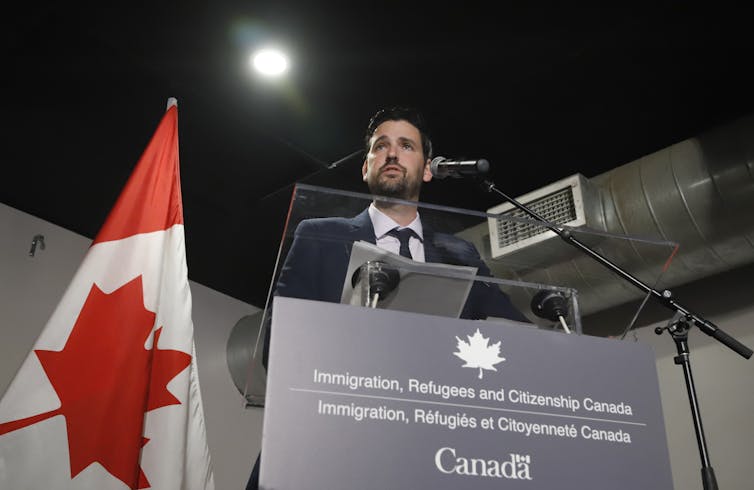
Temporary policy measures
An Oct. 7 announcement from Immigration, Refugees and Citizenship Canada (IRCC) about extending temporary pandemic measures allowing international students to study online from abroad while remaining eligible for a post-graduation work permit was made in favour of international students. However, this is, at best, a short-term strategy.
IRCC also said it will redirect resources to manage the backlog of study permit applications.
These strategies were only administered after months of consistent outreach by national associations and communities advocating on behalf of international students.
Similarly, IRCC’s recent decision to temporarily lift the limit on off-campus work hours may help ease some of the financial constraints for international students.
However, these students will still require additional work permits for co-op terms and internships that are part of their academic programs.
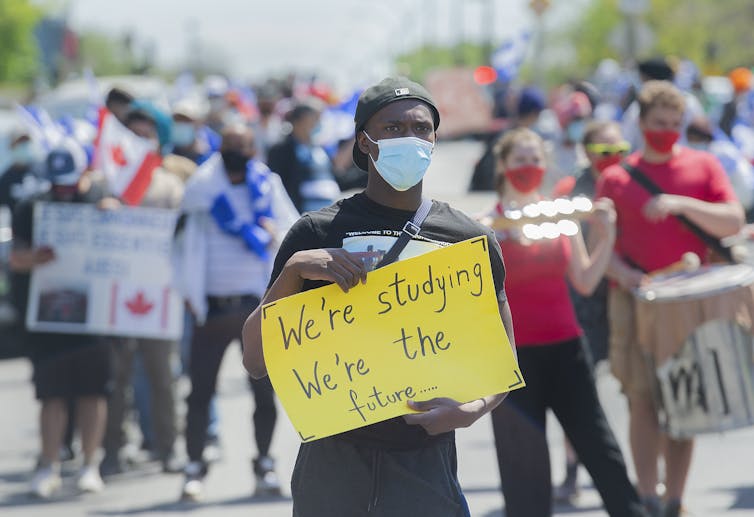
Racism and discrimination
One of the main reasons Canada is chosen as a destination of study is its reputation as a safe and tolerant society.
However, research suggests that experiences of racism and discrimination are not uncommon for international students.
A recent survey by the Canadian Bureau for International Education reported increased instances of discrimination and racism experienced by international students, particularly those who identified as Black.
Their experiences are similar after graduation. Research has indicated that international graduates in Canada are typically offered low-skilled forms of employment.
After graduation, international students continue to earn less than their domestic counterparts.
In some areas, they’re used as cheap contingent workers.
Employers are approximately 40 per cent more likely to interview job applicants with an English-sounding name, reducing the likelihood of international applicants to be shortlisted for jobs they qualify for.
Health and well-being
A study examining housing challenges faced by university students in Toronto found that students, especially those without financial support from their families, tend to work extra hours and take on multiple jobs to be able to afford rent.
Researchers have also highlighted how the pandemic exposed the vulnerability of international students, creating psychological stress and anxiety.
The limited options for affordable accommodation and students’ inability to meet the requirements of producing references and credit scores makes them even more vulnerable to housing scams.
Given the current low vacancy rates in the housing market, the situation is not likely to get better post-pandemic as international students arrive in Canada for in-person classes.
Retaining, supporting students
Despite having a multi-year international education strategy, studies show that our new international students and graduates continue to struggle with social and professional barriers. These barriers create an environment for them that is not as welcoming as Canada purports it to be.
An overemphasis on economic growth has led to the creation of a system that identifies international students as “ideal immigrants” but doesn’t do enough to support their settlement.
Retention data of international students who completed their studies between 2010 and 2016 indicates that less than half of all international students remained in their province of study in the year after graduation and that many of them may have left Canada after graduating.
As Canada ramps up efforts to increase international student enrolment by offering them additional pathways to residency, there is an urgent need to improve support and retention strategies if we expect students to contribute to our sustained growth and post-pandemic recovery.
As a developed nation standing up for principles of equity, diversity and inclusion, we need to do better.
The federal government’s latest immigration level plan aims to welcome up to 500,000 immigrants per year to the country by 2025, signalling the need to invest significant resources to ensure that these new immigrants are supported when they arrive.
From government entities that control their immigration status, businesses that employ them and members of the communities to which these students and graduates belong, both policy-makers and people at the local level have significant roles to play in shaping the lives of international students who study in Canada and aim to build a life here.![]()
Isaac Garcia-Sitton, PhD student, Education: Language, Culture & Teaching, York University, Canada
This article is republished from The Conversation under a Creative Commons license. Read the original article.
Controversial Nigerian socialite Hushpuppi sentenced 11 years in prison by US court
Sunday, 06 November 2022 03:11 Written by africanews 
Popular Instagram celebrity, Ramon Abbas AKA Hushpuppi has been sentenced to 11 years imprisonment by the United States Central District Court in California for fraud and money laundering.
Recall that Hushpuppi was arrested in June 2020 in Dubai over an extensive fraud scheme that has robbed victims of their money in the U.S, Qatar, the United Kingdom, and other places.
He was then extracted to the United States where he was charged with fraud and money laundering, multiple counts of hacking, impersonation, scamming, banking fraud, and identity theft.
He, however, pleaded guilty to the charges of conspiracy to engage in money laundering.
Following the sentence on Friday (November 4), Hushpuppi will now spend only nine years in prison as he had already spent two years incarcerated in the US.
Hushpuppi had appealed to Judge Otis Wright narrating his source of wealth, criminal adventure, and regrets.
He commended the Federal Bureau of Investigation (FBI) for doing a thorough job in bringing him to justice and apologized to his family.
Better income assistance programs are needed to help people with rising cost of living
Saturday, 22 October 2022 03:42 Written by theconversation 
Wayne Simpson, University of Manitoba
At the onset of the pandemic, the Canadian federal government cobbled together a series of programs to help vulnerable populations who needed support. These measures included boosts to Canada Child Benefit payments, the goods and services (GST) tax credit and the Old Age Security and Guaranteed Income Supplement for seniors.
This choice of programs is telling in two important respects. First, they all came in the form of income-tested monthly benefits paid through the tax system. Secondly, the programs were mostly directed at families with children and seniors, with the exception of the GST credit that provides tax-free payments to individuals and families across Canada at or below the poverty line.
The addition of the Canada Emergency Response Benefit for workers who lost significant income during the pandemic, along with liberalized eligibility rules for Employment Insurance, were necessary but still left large gaps in protection for others who were economically vulnerable, notably singles and couples without children.
The provincial governments, who are in charge of social and welfare assistance in Canada, largely left pandemic income support to the federal government. More recently, the provinces have been active in attempting to cushion the impact of rising energy prices and inflation, as federal assistance measures expire.
Diversity of assistance programs
Alberta, Newfoundland and Ontario have introduced temporary reductions in gas taxes, which are directed at families in general rather than those with lower incomes. Québec introduced a non-taxable $500 benefit to taxpayers with incomes under $100,000 in 2021, with reduced payments for incomes up to $150,000.

In 2021, Manitoba provided families with household incomes under $175,000 a $250 benefit for their first child and $200 for each additional child. They also provided $300 benefits for senior households with incomes under $40,000 who claimed the education property tax credit in 2021, or received provincial Employment and Income Assistance.
British Columbia is quadrupling the fourth quarter federal Climate Action Tax Credit, which is based on net income and family size. There is clearly a vast diversity of social assistance programs at both the federal and provincial levels — but are they enough to help those in need?
Building assistance programs
Underlying these government programs is a historic framework that comes down to three principles: benefit coverage, government generosity, and tapering or reducing the benefits based on income.
In Canada, most social assistance programs are limited or conditional, meaning recipients must meet certain criteria to receive support. Programs tend to be geared toward seniors, families with children and working age adults with imposed employment conditions. While universal coverage has been around since 1962, it has never gone beyond the experimental stage in North America.
The distribution of income assistance often comes down to the question of who in need of help will actually receive support. In other words, these programs depend on generosity: Who is and is not deserving of coverage? This generosity depends both on the fiscal capacity of governments and their willingness to devote resources to the assistance of those in need.
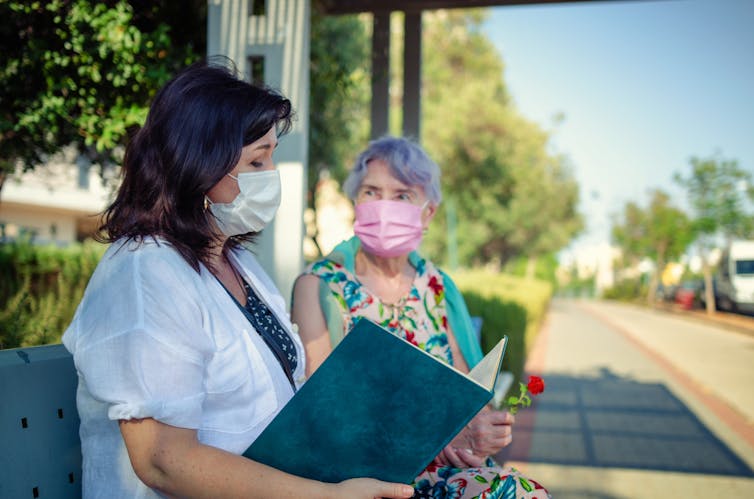
It’s clear that current federal and provincial income support falls short of Canada’s official poverty line, now enshrined under the Poverty Reduction Act. This is especially significant for non-elderly adults without children who do not receive federal child or seniors benefits.
The effectiveness of social programs also depends on how they are tapered. Tapering refers to the way benefits are distributed to program recipients. Tapering on the basis of family income has been a hallmark of Canadian income supports since the early proposals for a guaranteed basic income, with lower income families receiving larger amounts of benefits for a given financial outlay.
Tapering characterizes the main federal income support programs and was explicit in the reasoning behind the current Canada Child Benefit that replaced the Universal Child Care Benefit. However, the benefit is not tapered enough — it guarantees families with incomes up to $200,000 receive benefits. This limited tapering means those with the greatest need get less than they might otherwise.
Better support for Canadians
It’s clear that Canada’s current income assistance programs are not doing enough to support Canadians. Canadians are increasingly turning to crowdfunding sites for support to keep them afloat during personal and family crises.
If the goal of temporary assistance is to help those in need, it must have broader coverage and better tapering. The only program that qualifies at present is the GST credit, but even these payments are modest and only delivered quarterly.
The federal government has just decided to double the GST credit for six months to deliver additional relief to these low-income families, but a family of four will only receive a maximum of an additional $467 a year from this measure.
A more generous income assistance program should also have more frequent regular payments. Expanding the GST credit might be more helpful, but other ways to supplement or replace provincial social assistance programs, such as a guaranteed basic income for working-age Canadians, might provide better support for those in need.![]()
Wayne Simpson, Professor, Department of Economics, University of Manitoba
This article is republished from The Conversation under a Creative Commons license. Read the original article.
Georgia College Student Killed 'Instantly' by Plane Propeller During Extravagant Dinner Date
Saturday, 22 October 2022 02:50 Written by statesboroheraldA man who died as the result of an accident on the ground Sunday night at the Statesboro-Bulloch County Airport has been identified by the coroner as Sani Aliyu, a Georgia Southern University student who had an Atlanta home address and was originally from Nigeria.
A small plane in which Aliyu, 21, was a passenger landed safely, but he was reportedly struck by the propeller after getting out of the plane. Bulloch County 911 dispatched emergency services to the airport shortly before 10:45 p.m. Sunday, Oct. 16. Bulloch Coroner Jake Futch, who pronounced Aliyu dead at the scene, released his identity Monday afternoon.
Aliyu had been one of four occupants of the 2005 Cessna 172S when it landed without incident around 10:35 p.m., according to a preliminary statement from Steve Kulm, public affairs specialist with the Federal Aviation Administration.
The other people on board were the pilot, a co-pilot and another passenger who was a friend of Aliyu’s, according to Capt. Todd Hutchens of the Bulloch County Sheriff’s Office. Futch referred to the friend as a young woman with whom Aliyu had been on a date, and he and Hutchens said Aliyu apparently also knew the pilot and co-pilot, but authorities were not naming any of the others as of Monday.
“They flew to Savannah to go on a date, flew back, landed at the Statesboro Airport, and the young lady got off the plane and walked toward the back of the plane, and he got off the airplane and walked toward the front of the plane, and when he did, the propeller hit him,” Futch said.
The Bulloch County Emergency Medical Service responded with an ambulance, but Aliyu had been struck twice in the head by the propellor and died immediately, the coroner said.
University statement
Futch said he saw information indicating that Aliyu was originally from Nigeria.
Communications Manager Melanie Simón in Georgia Southern University’s communications and marketing office confirmed that Aliyu was a current student — a sophomore majoring in management — from Atlanta but had no information on his birthplace or national origin. Simón provided a statement from Dr. Aileen C. Dowell, the university’s dean of students and associate vice president.
“We were deeply saddened to hear about the tragic incident that involved one of our students Sunday night,” Dowell said. “I have already been in touch with his family and professors, and we have mobilized all available resources to provide counseling and any other assistance the university can give.”
Hutchens confirmed that the Sheriff’s Office had responded Sunday night and collected information but said that details would be turned over the FAA and the National Transportation Safety Board.
“Nobody is really at fault or anything, it was an accident, so we just have to communicate all of our information with them,” Hutchens said.
The accident occurred with the plane stationary on the ground, near where planes are parked, he noted.
FAA and NTSB
Kulm, the FAA spokesperson, in an email reply referred to the accident as having occurred “after the plane taxied onto the ramp area.”
“The FAA and NTSB will investigate. The NTSB will be in charge of the investigation and will provide all updates,” Kulm wrote.
He stated that neither agency identifies people involved in aircraft accidents. But he provided the aircraft’s registration number. The FAA registry database identifies American Aviation Inc., a dealership and aircraft services company in Brooksville, Florida, as registered owner of the four-seat, single-engine Cessna 172S.











